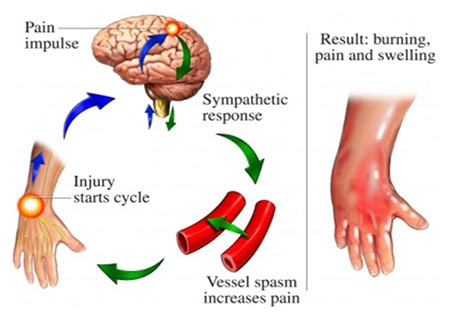 Midtown Manhattan
36 W 44th St Ste 1416 New York, NY 10036
Midtown Manhattan
36 W 44th St Ste 1416 New York, NY 10036
- (212) 621-7746
- text us
- BOOK ONLINE Call for Same Day Appointments
 Midtown Manhattan
36 W 44th St Ste 1416 New York, NY 10036
Midtown Manhattan
36 W 44th St Ste 1416 New York, NY 10036
Reflex sympathetic dystrophy syndrome is a chronic regional pain syndrome that causes severe pain. Since it’s so rare, chronic regional pain syndrome treatment must come from an experienced team of Manhattan pain management doctors. Reflex sympathetic dystrophy treatment may be required shortly after you receive a trauma that damages your nervous system. On the other hand, sympathetic reflex dystrophy treatment may not even be recognized as a viable solution until years after an event.
 Reflex sympathetic dystrophy syndrome (RSDS) is considered a rare disease, one that causes severe pain that’s chronic. In other words, it lasts for a long time and cannot be cured. Also called chronic regional pain syndrome, the condition attacks your sympathetic nervous system.
Reflex sympathetic dystrophy syndrome (RSDS) is considered a rare disease, one that causes severe pain that’s chronic. In other words, it lasts for a long time and cannot be cured. Also called chronic regional pain syndrome, the condition attacks your sympathetic nervous system.
The sympathetic nervous system is part of your autonomic nervous system that drives your heart rate, blood vessel constriction and elevating blood pressure. It’s an involuntary process that, when affected by chronic regional pain syndrome, leads to the pain for which you need reflex sympathetic dystrophy treatment. In Manhattan, your pain management team at the Sports and Pain Institute of NY provides targeted, individualized sympathetic reflex dystrophy treatment.
RSDS often is confused with other painful conditions, most notably pinched nerves, sciatica and other nerve disorders. Sometimes, the skin surrounding the source of your pain turns red and swollen, leading some to think they have knee tendonitis or a labral tear.
Arm and shoulder pain or leg pain localized in a knee or hip are the most common places where RSDS shows up. The primary symptom of RSDS is burning accompanied by:
Very often, the pain intensifies over three to six months from when you first notice it. While the first inkling of RSDS can appear following a traumatic injury, the pain moves slowly and radiates to other parts of your body. And it becomes more severe as time goes on. Your range of motion gets restricted and your skin may become mottled or pitted around the pain point. Your skin can even turn blue when blood flow is restricted.
Before he can develop a customized sympathetic reflex dystrophy treatment plan, your NYC physician needs to conduct a thorough medical history. Prepare to provide details about the severity of your pain, when it first started and what makes it feel worse or better. Include information about previous injuries or traumas because, even though there is no known cause for RSDS, most people who develop the disease have had one or more of the following incidences:
Anyone at any age can develop RSDS, but it tends to occur more frequently in women between the ages of 40 and 60. Tests such as x-rays, readings of your skin temperature, bone scans and thermographic studies help your New York pain management doctor develop a chronic regional pain syndrome treatment plan. One of the most definitive tests to diagnose RSDS is a sympathetic block. A positive response to the nerve block tells your doctor that you most likely have RSDS.
Very friendly and professional. I would recommend Dr Melepura to anyone who might need his services and plan to go back myself in the future. Overall good experience
Jeremy PicardThere is no one definitive sympathetic reflex dystrophy treatment that works for everyone. If you begin treatment as soon as symptoms appear, however, you have a better chance of preventing the progression of the painful disease.
Nerve block and trigger point injections often provide you with substantial relief from the pain. Side effects are rare when you receive low-dose injections as a chronic regional pain syndrome treatment. The side effects that do appear include:
Because of the rarity of the disease and the many different causes and symptoms, you need to trust your Midtown Manhattan pain management doctor to diagnose your condition and provide the right kind of chronic regional pain syndrome treatment available.
so many other conditions that your physician may try a variety of tests and treatments to come to a definitive conclusion. Some of the disorders related to RSDS include:
Do you have any questions about the Reflex sympathetic dystrophy (RSD) treatment we offer in NYC? Would you like to schedule an appointment with the best rated arm and leg pain management doctor Febin Melepura MD of sports pain management clinic in NYC? Please contact our office for consultation with the top pain relief specialist in Midtown Manhattan.
Sports Injury & Pain Management Clinic of New York
Febin Melepura, MD is a top rated, best in class interventional pain management doctor. He is a nationally recognized pain relief specialist and is among the top pain care doctors in New York City and the country. He is an award winning expert and contributor to a prominent media outlets.
Dr. Febin Melepura has been recognized for his thoughtful, thorough, modern approach to treating chronic pain and, among other accolades, has been named a “top pain management doctor in New York”, and one of “America’s Top Doctors™” for an advanced sports injury treatments.